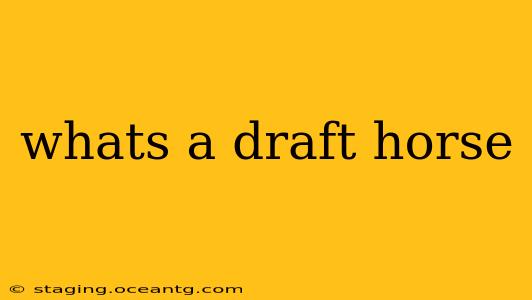Draft horses, also known as draught horses, are large, powerful breeds of horses specifically bred for their strength and ability to perform heavy work. Unlike lighter breeds used for riding or racing, draft horses are characterized by their immense size, muscular build, and calm temperament, making them ideal for tasks requiring significant pulling power. Think of them as the heavy-lifting heroes of the equine world! This article will delve into the fascinating world of draft horses, exploring their history, characteristics, uses, and the reasons behind their enduring appeal.
What are the characteristics of a draft horse?
Draft horses are easily identifiable by their distinct physical features. They are significantly larger than other horse breeds, typically standing between 16 and 19 hands high (64 to 76 inches at the withers). Their bodies are powerfully built, with deep chests, broad shoulders, and strong, sturdy legs. This robust physique gives them the muscle mass needed to pull heavy loads. Their coats are often thick and shaggy, providing insulation against harsh weather conditions. Common coat colors include bay, black, chestnut, and gray, although variations exist within different breeds.
What breeds of horses are considered draft horses?
Several breeds fall under the umbrella of "draft horse." Some of the most well-known include:
- Belgian Draft Horse: Known for their muscular build and reddish-brown coat.
- Clydesdale: Easily recognizable by their feathered legs and impressive stature.
- Percheron: A French breed often exhibiting a gray or black coat.
- Shire: One of the largest draft horse breeds, originating in England.
- Suffolk Punch: A rare breed characterized by its distinctive chestnut coat.
Each breed has its own unique characteristics and history, but they all share the common trait of exceptional strength and pulling power.
What is the history of draft horses?
The history of draft horses is deeply intertwined with the development of agriculture and transportation. For centuries, these powerful animals were essential for plowing fields, hauling heavy loads, and powering machinery. Their strength was crucial in an era before mechanized equipment, making them invaluable to farmers and businesses alike. The rise of modern machinery in the 20th century led to a decline in the use of draft horses for agricultural work, but they have found new roles in activities such as logging, pulling competitions, and even recreational driving.
What are draft horses used for today?
While their role in agriculture has diminished, draft horses remain relevant in various aspects of modern life. They are often used in:
- Agricultural work: While less common than in the past, draft horses still find applications in specialized agricultural settings or for conservation tillage.
- Logging: Their strength is invaluable in logging operations, particularly in areas where heavy machinery is impractical.
- Recreational driving: Many people enjoy driving draft horses for leisure, participating in parades, shows, and driving competitions.
- Therapeutic riding: Their calm temperament makes them suitable for therapeutic riding programs.
Are draft horses good for riding?
While certainly capable of carrying riders, draft horses are not typically used for riding in the same way as lighter breeds. Their size and build make them less agile and maneuverable than breeds bred specifically for riding, and their strength can be overwhelming for inexperienced riders. However, many experienced riders find them suitable for pleasure riding or driving.
How much do draft horses weigh?
The weight of a draft horse varies depending on the breed, age, and individual horse, but they typically weigh between 1,800 and 2,200 pounds (816 to 998 kg). Some exceptionally large individuals can weigh even more.
How much do draft horses cost?
The cost of a draft horse can vary widely depending on factors such as breed, age, training, and lineage. Prices can range from several thousand dollars to tens of thousands of dollars for well-bred and trained animals.
What are the advantages and disadvantages of owning a draft horse?
Advantages:
- Strength and power: Their immense strength makes them capable of handling heavy tasks.
- Calm temperament: Draft horses are generally docile and easy to handle.
- Versatility: They can be used for a variety of tasks, from agricultural work to recreational driving.
Disadvantages:
- Large size and space requirements: They need significant space for stabling and exercise.
- High feed costs: Their large size means they require substantial quantities of feed.
- Specialized care: Their specific needs may require specialized veterinary care and farrier services.
In conclusion, draft horses represent a remarkable combination of strength, gentleness, and historical significance. While their role in modern society has evolved, their enduring appeal is a testament to their inherent power and captivating nature. Whether admired for their majestic appearance or appreciated for their unwavering strength, these gentle giants continue to hold a special place in the hearts of many.
